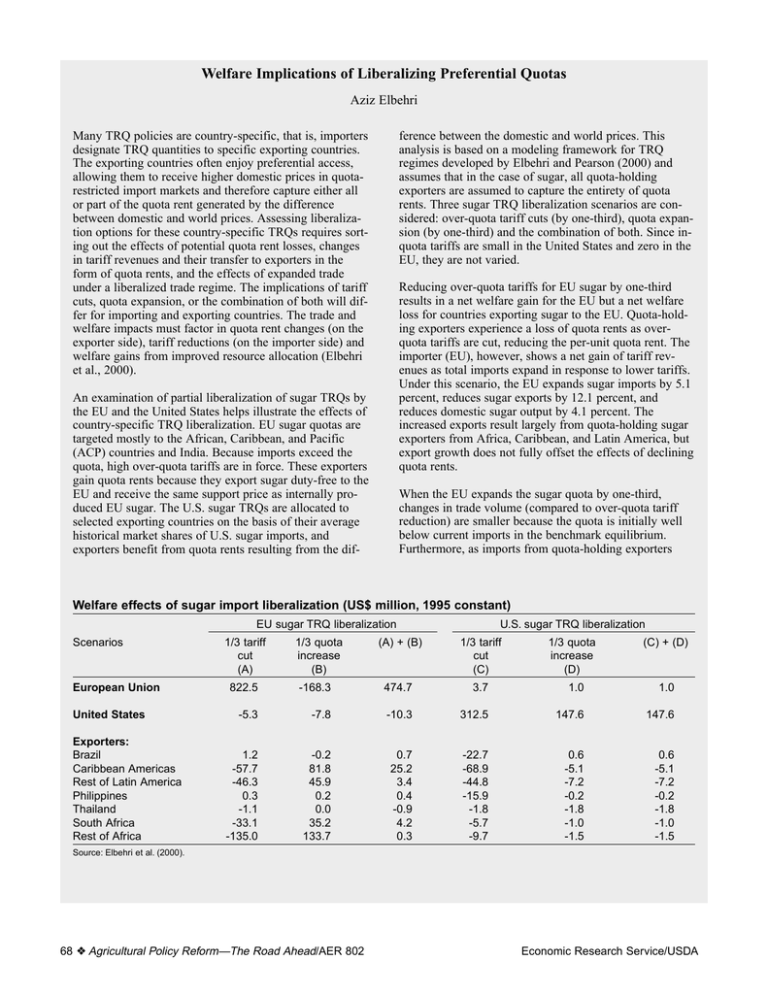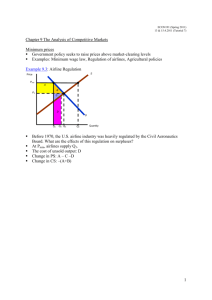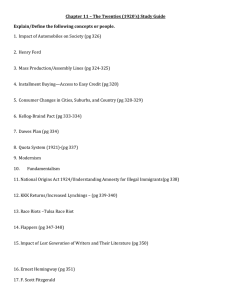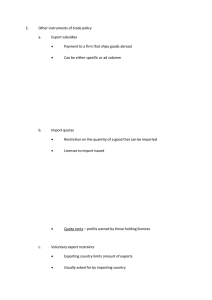Welfare Implications of Liberalizing Preferential Quotas
advertisement

Welfare Implications of Liberalizing Preferential Quotas Aziz Elbehri Many TRQ policies are country-specific, that is, importers designate TRQ quantities to specific exporting countries. The exporting countries often enjoy preferential access, allowing them to receive higher domestic prices in quotarestricted import markets and therefore capture either all or part of the quota rent generated by the difference between domestic and world prices. Assessing liberalization options for these country-specific TRQs requires sorting out the effects of potential quota rent losses, changes in tariff revenues and their transfer to exporters in the form of quota rents, and the effects of expanded trade under a liberalized trade regime. The implications of tariff cuts, quota expansion, or the combination of both will differ for importing and exporting countries. The trade and welfare impacts must factor in quota rent changes (on the exporter side), tariff reductions (on the importer side) and welfare gains from improved resource allocation (Elbehri et al., 2000). ference between the domestic and world prices. This analysis is based on a modeling framework for TRQ regimes developed by Elbehri and Pearson (2000) and assumes that in the case of sugar, all quota-holding exporters are assumed to capture the entirety of quota rents. Three sugar TRQ liberalization scenarios are considered: over-quota tariff cuts (by one-third), quota expansion (by one-third) and the combination of both. Since inquota tariffs are small in the United States and zero in the EU, they are not varied. Reducing over-quota tariffs for EU sugar by one-third results in a net welfare gain for the EU but a net welfare loss for countries exporting sugar to the EU. Quota-holding exporters experience a loss of quota rents as overquota tariffs are cut, reducing the per-unit quota rent. The importer (EU), however, shows a net gain of tariff revenues as total imports expand in response to lower tariffs. Under this scenario, the EU expands sugar imports by 5.1 percent, reduces sugar exports by 12.1 percent, and reduces domestic sugar output by 4.1 percent. The increased exports result largely from quota-holding sugar exporters from Africa, Caribbean, and Latin America, but export growth does not fully offset the effects of declining quota rents. An examination of partial liberalization of sugar TRQs by the EU and the United States helps illustrate the effects of country-specific TRQ liberalization. EU sugar quotas are targeted mostly to the African, Caribbean, and Pacific (ACP) countries and India. Because imports exceed the quota, high over-quota tariffs are in force. These exporters gain quota rents because they export sugar duty-free to the EU and receive the same support price as internally produced EU sugar. The U.S. sugar TRQs are allocated to selected exporting countries on the basis of their average historical market shares of U.S. sugar imports, and exporters benefit from quota rents resulting from the dif- When the EU expands the sugar quota by one-third, changes in trade volume (compared to over-quota tariff reduction) are smaller because the quota is initially well below current imports in the benchmark equilibrium. Furthermore, as imports from quota-holding exporters Welfare effects of sugar import liberalization (US$ million, 1995 constant) EU sugar TRQ liberalization Scenarios European Union United States Exporters: Brazil Caribbean Americas Rest of Latin America Philippines Thailand South Africa Rest of Africa 1/3 tariff cut (A) 1/3 quota increase (B) U.S. sugar TRQ liberalization (A) + (B) 1/3 tariff cut (C) 1/3 quota increase (D) (C) + (D) 822.5 -168.3 474.7 3.7 1.0 1.0 -5.3 -7.8 -10.3 312.5 147.6 147.6 1.2 -57.7 -46.3 0.3 -1.1 -33.1 -135.0 -0.2 81.8 45.9 0.2 0.0 35.2 133.7 0.7 25.2 3.4 0.4 -0.9 4.2 0.3 -22.7 -68.9 -44.8 -15.9 -1.8 -5.7 -9.7 0.6 -5.1 -7.2 -0.2 -1.8 -1.0 -1.5 0.6 -5.1 -7.2 -0.2 -1.8 -1.0 -1.5 Source: Elbehri et al. (2000). 68 ❖ Agricultural Policy Reform—The Road Ahead/AER 802 Economic Research Service/USDA rise, so, too, does their price, limiting the growth in demand. Expanding the EU’s sugar quota transfers EU tariff revenue to exporters in the form of higher quota rents. Consequently, expanding quotas by one-third leads to net welfare gains by the quota-holding exporters while the liberalizing country (EU) shows a net welfare loss from reduced tariff revenues. However, the combination of tariff reductions and quota expansion results in welfare improvement for both the importing and the exporting countries. This welfare gain reflects both the increase in exporters’ quota rents and the increase of importer’s tariff revenue. The United States imports little sugar over the quota, thus, there is much less scope for transferring over-quota tariff revenues to exporters as is the case with the EU. Increasing the U.S. sugar TRQ means all sugar import expansion in the United States occurs within the quotas. In this case, per-unit quota rents fall sharply, and the welfare of the quota-holding sugar exporters declines. The exporters’ welfare declines less if over-quota tariffs are cut. The United States shows a welfare gain under both tariff cuts and quota expansion due to expanded imports under either case. The trade and welfare implications from this empirical analysis of sugar TRQ liberalization lead to two important results. First, in those country-specific TRQ cases where imports exceed quotas and where some exporters capture quota rents as a result of preferential access, the welfare effects of liberalization depend on what happens to both over-quota tariffs and quota volumes. Second, developing countries that export to industrialized markets under preferential access can suffer welfare losses under over-quota tariff reductions due to a loss of quota rents. At the same time, exporters that do not benefit from allocated quotas are poised to benefit from a more liberalized trading regime, as they are likely to expand exports without having to withstand an erosion of preferential margins or quota rents. Economic Research Service/USDA Since country-specific TRQs by importing industrialized economies are justified as a form of foreign assistance, one policy implication is that tariff cuts negotiated as part of a multilateral agreement could also be complemented with higher quotas, therefore minimizing the welfare losses on those exporting developing countries with preferential treatment. In the long run, however, high-cost producers from developing countries would benefit less from foreign assistance than from shifting their economic activities toward areas in which they enjoy competitive advantage. A move toward a more liberalized trade regime would strongly encourage these adjustments of economic activities, which would benefit developing economies. References Elbehri, A., and K.R. Pearson (2000), “Implementing Bilateral Tariff Rate Quotas in GTAP using GEMPACK,” Global Trade Analysis Project (GTAP) Technical Paper No. 18. Elbehri, A., T.W. Hertel, M. Ingco, and K.R. Pearson (2000), “Partial Liberalization of the World Sugar Market: A General Equilibrium Analysis of Tariff-Rate Quota Regimes,” Presented at the AAEA Annual Meetings, July 30-August 2, Tampa, Florida. Agricultural Policy Reform—The Road Ahead/AER 802 ❖ 69






